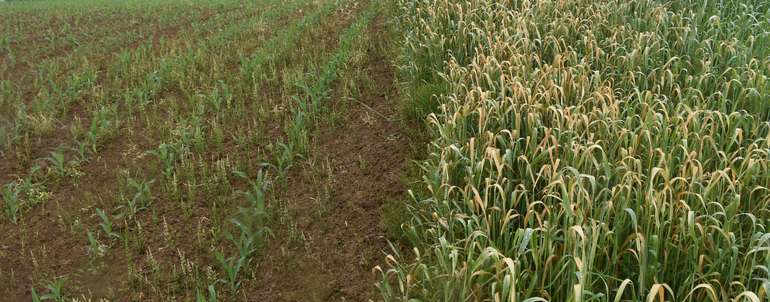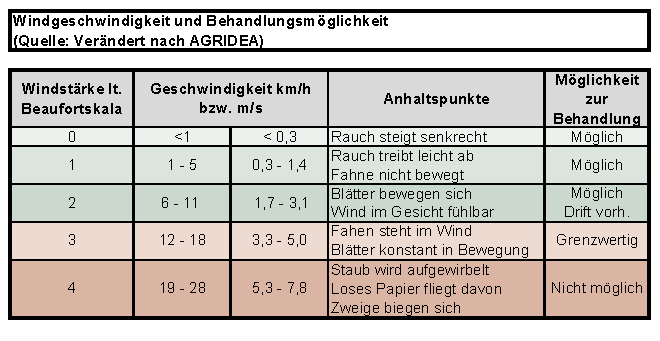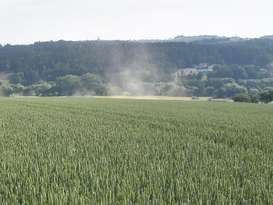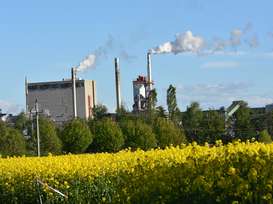18/01/2024
Drift prevention during crop protection work
Source: Upper Austrian Chamber of Agriculture
The topic of drift continues to be hotly debated. A dedicated project has addressed the issue, and extensive information is available. When applying crop protection measures, it is essential to prevent drift into neighboring areas.
Unfortunately, damage caused by drift occurs again and again. With herbicides, the effects are easily visible, especially in the border areas of neighboring fields. In recent years, however, there have often been no abnormalities; only laboratory analysis has revealed contamination with pesticides (e.g., terbuthylazine). Fungicide or insecticide drift can only be detected through laboratory analysis. In recent years, it has been detected primarily in crops that were harvested shortly after pesticides were applied to neighboring fields (strawberries, herbs).

Drift onto neighboring areas must be avoided at all costs © Upper Austria Chamber of Agriculture/Köppl
According to legal requirements, plant protection work must not have any negative impact on neighboring properties (Upper Austrian Soil Protection Act, General Civil Code). Therefore, all precautionary measures must be observed during plant protection work to avoid drift.
Which measures help?
According to good professional practice, when using the best technology (e.g., drift-reducing nozzles), crop protection work may be carried out up to a maximum wind speed of 5 m/s (approximately 18 km/h). Without this technology, 3 m/s is the limit. A table is provided below that may be helpful. Some weather reports are already tailored to the application of crop protection products (e.g., spritzwetter.at), and Syngenta also offers its own app (Spray Assist), which allows you to find the optimal spraying time under the given weather conditions.
Anemometers are also available from specialist retailers, allowing you to determine wind speed. The speed is measured at the height of the nozzle.
Drift-reducing nozzles produce droplets with a larger volumetric diameter, allowing them to sink more quickly into the crop and penetrate it better. As with surface waters, it is recommended to reduce the pressure and speed (e.g., 7 to 8 km/h) for sensitive crops at a certain distance (e.g., 20 m).
The optimal distance between the nozzles and the target surface is 50 cm for most nozzles. This is often greatly underestimated. If the distance to the target surface is increased by ten centimeters, drift can increase by up to 100% in adverse weather conditions.
Along critical areas, it is recommended to postpone application to a more optimal date, even if there is only slight wind in their direction.
Tests with spray liquid additives (e.g. Squall, Silwet Top) show that certain drift-reducing effects can be achieved.

Wind force table © Chamber of Agriculture of Upper Austria/Köppl
In the immediate vicinity of neighboring fields, turning off the outer nozzles is one way to avoid impacts. Special edge nozzles are available from specialist retailers. These allow for effective control right up to the edge of the field, where weed pressure is sometimes higher. In particularly sensitive areas, creating a buffer strip can also help prevent impacts.

Thermals can carry small drops very far © Upper Austrian Chamber of Agriculture/Köppl
Thermal drift also plays a significant role in long-distance transport. At temperatures above 25°C and with relatively fine droplet application, this risk increases significantly. It is also often underestimated that below 50% relative humidity, the lifetime of fine droplets in particular is very short, and that thermal forces can carry the active ingredients over long distances. Products based on pendimethalin, prosulfocarb, and clomazone are particularly at risk. Very low air humidity can also reduce the effectiveness of herbicides.

At wind speeds above 5 m/s, plant protection is no longer permitted. © Upper Austria Chamber of Agriculture/Köppl
The application of pesticides is also possible in the late evening hours, as long as there is no dew and the droplets do not run off. In the morning hours, there is usually less wind but perhaps more dew – this poses the risk of the droplets running off, and depending on the product, if the wax layer is still soft, there is a risk of chemical burns.
Drift onto neighboring fields, field margins, and wooded areas must be avoided at all costs. Field margins and flower strips are home to many beneficial insects that must not be disturbed. Drift onto neighboring organic fields also poses serious problems for the farmer – the field loses its "organic status," the produce must be marketed conventionally, and the affected field becomes an organic conversion area again.
If drift has occurred onto neighboring properties, the landowner or manager must be informed immediately.
Detailed information on drift prevention was developed as part of an LE project. This information is available at the address "Reducing pesticide inputs to non-target areas | Austrian Chamber of Agriculture" (lko.at).
You can find all products on this topic here: Field sprayer parts
